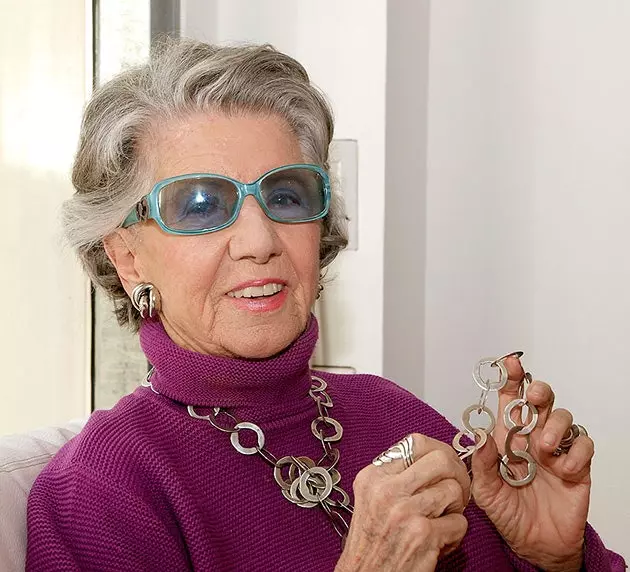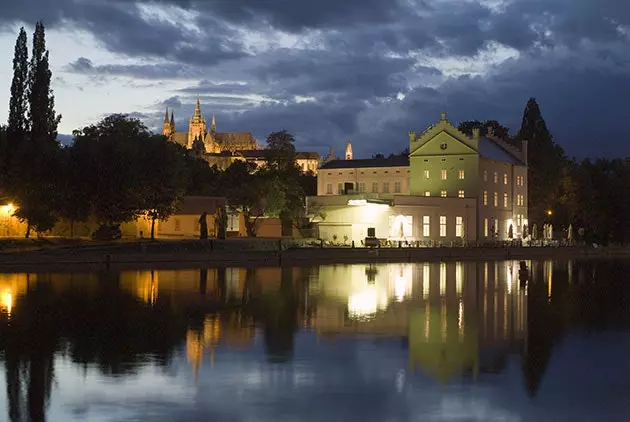
Meda Mladek, the great lady of Czech art
The print requires a commitment to the imagination: imagine Baroness Thyssen in a lilac robe, pink socks and slippers at the door of her house feeding the pigeons, right in front of the Thyssen-Bornemisza Museum in Madrid.
Let us return to Prague, from where this article is being written, in a country that when it was called Czechoslovakia suffered a communist coup in 1948 that began with a ban on the imagination . Cheap adventure, science fiction or love novels were sharply censored because they recreated a world that was deceitful and inferior to that of the new idyllic reality. Pure unpatriotism, they said.
Meda Mladek always believed in the imagination of art and in 1946 she emigrated never to return . She first to Geneva, where she studied economics, and from 1954 to Paris, where she studied art history and surrounded herself with artists. There she met the Czech painter Frantisek Kupka, one of the great pioneers of abstraction. "He practically died in my arms," she remembers sitting on the couch in her house.

The Museum Kampa, located on the most beautiful island in Prague
Meda Mladek was born in 1919. She never met the brilliant Czech sculptor Otto Gutfreund, who drowned in an anxiety attack in the Vltava river in 1927 and who in 1911, in a fit of imagination, molded one of the first cubist sculptures that there was in the world.
She did, she met the Pole Jan Mladek instead , whom she went to visit with the intention of asking for funds to finance the small publishing house she had started in Paris, Edition Sokolova. Money for the imagination. Jan Mladek worked with Keynes on the Marshall Plan and was the first director of the International Monetary Fund in Europe. He had money, influence and believed in art as a weapon for the survival of a nation. Everything fit. In 1960 they got married.
From that moment they began a collecting and patronage work that had a single objective: encourage the work of Czechoslovakian artists repressed by the communist regime . Also that of other European artists. Both those who were in foreign and internal exile. So Meda Mladek, 19 years later, had to go back to Prague. She and she would frequently.
Her attachment to her imagination was not retaliated against. Quite the contrary.
In Rock, Paper, Scissors, paper beats rock. . During the communist dictatorship, the role of dollars overcame the steel of the curtain.
Before starting the interview where she tells me how she bought the works that make up one of the most important art collections in Europe, I toured the museum where it is exhibited and which she directs, the Kampa Museum , on the banks of the Vltava river. The headquarters is an old medieval mill that she was in charge of restoring with the support of the Prague City Council. In 1989 it was so abandoned that it looked like a squat, despite its privileged location in the aristocratic neighborhood of Malá Strana, next to the very Charles Bridge and near the Lennon Wall, the graffiti-filled monument that honors the Beatles musician.

The interior of the Museum Kampa
If you walk from one side of the building to the other, from the window overlooking Charles Bridge to the window where I first see Meda Mladek at her door, in lilac dressing gown, pink socks and slippers throwing seeds at the pigeons , you follow part of the journey that Meda Mladek made in the 60s and 70s: Czechoslovakia, Poland, Hungary, Yugoslavia... For years she traveled to the countries under the Soviet orbit in search of works by persecuted or marginalized artists , that her presence in museums and galleries was vetoed and whose promotion was prohibited.
"You don't have to have much imagination," explains Meda Mladek naturally; "it all comes down to money . They knew who my husband was, they knew who I was. The Czechoslovak communist government was in dire need of American cash. They needed foreign currency. The work of artists such as Jiří Kolář, Načeradský or Nepraš could not be exhibited in museums in Czechoslovakia, but their sale abroad was not prohibited. The key was to know them, to know what they were working on at that time –which was not easy within the country, imagine abroad–, to have the contacts and, of course, to have the dollars".
It was always like this? "Until 1984. From that year the measures became more radical and the police denied me entry into my own country until the fall of communism in 1989. But I continued to work with artists from Poland, Hungary and the countries of the former Yugoslavia" .
Her house, a neighboring dwelling, is a natural extension of the museum . The living room, with a kitchenette in one corner and stacked with books and papers, looks like a college girl's apartment. On the wall rules a vivid Lombard-colored tapestry by Jagoda Buic, which she exhibited earlier during the exhibition dedicated to the Croatian artist. She has photos with her friends: Václav Havel, Bohumil Hrabal, George Bush and Yoko Ono.
The Kampa also exhibits seminal works by Czech painter Frantisek Kupka and sculptor Otto Gutfreund in a single exhibition. "I always win," says Meda Mladek with a smile. She is 93 years old.
Museum Kampa: The Jan and Meda Mladek Foundation U Sovových mlýnu 2, Prague 1 - Malá Strana. Open every day from 10:00 to 18:00.
*** You may also be interested in...**
- Prague for modern
